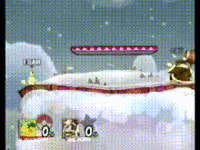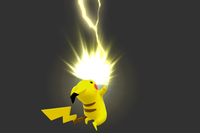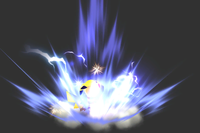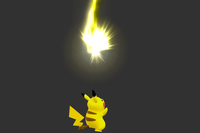Thunder (Pokémon)
| Thunder | |
|---|---|
{{{content1}}}
{{{content2}}} Thunder in Ultimate. | |
| Users | Pikachu Pichu |
| Universe | Pokémon |
| Article on Bulbapedia | Thunder (move) |
Thunder (かみなり, Thunder) is Pikachu and Pichu's down special move. It is not to be confused with Robin's neutral special move of the same name.
Overview
When used, the Pokémon yells as a bolt of lightning drops from the sky, damaging opponents in the Thunder's path. Upon hitting the user, a large shockwave is created, which deals more damage and knockback than the regular bolt, along with granting temporary invincibility to the user (this is best seen when using it on a Blast Box, where the Blast Box is destroyed, but the user isn't harmed). The lightning blast stalls the user in place for a while, so they can act more quickly if they are not stuck.
In Super Smash Bros.
In Super Smash Bros., this move has infinite vertical range and thus can be often used to score KO's when an opponent is near the upper blast line. This technique is called "Thunderspiking", and can lead to KO's at much lower percents. As a result, Pikachu players try to integrate it into their combos as often as they can, typically after an up smash. Even though the move is powerful, it has considerable ending lag. Regardless, it is considered one of Pikachu's best moves. The thunderbolt deals 12% damage and the shockwave deals 16%. Both hits can connect, making Thunder deal 28% when this occurs. Both the thunderbolt and shockwave have very high base knockback but low knockback scaling, making them very effective at KOing neat blastzones although they are not quite as effective at KOing from far distances. The shockwave is still a strong KO move regardless, being capable of KOing middleweights under 100% from the center of Dream Land. The move was later buffed in the PAL versions, with both the thunderbolt and shockwave dealing 2% more damage (14%/18% for a total of 32%) which made Thunder even more effective for KOing.
In Super Smash Bros. Melee
Pikachu
In Super Smash Bros. Melee, Thunder has seen a few improvements. The thunderbolt has less startup lag and the shockwave now deals 17%, making it stronger than it was in Smash 64 (though still weaker than its PAL incarnation and Pikachu can now no longer connect both the thunderbolt and the shockwave). However, the move has seen some noticeable downgrades, making it less effective than its Smash 64 counterpart. The most noticeable nerf is that the move now strikes from a cloud at a fixed height relative to the user (this is often not visible unless the stage is rather high). For example, if Pikachu or Pichu is under the upper-middle platform at Hyrule Temple and uses Thunder, one can see the cloud from where the thunder is generated, but the lightning will not go through the platform, making the attack useless in that particular location. The thunderbolt is considered to be a projectile and can be reflected back at Pikachu or absorbed for health (which could not be done in Smash 64). The Thunderbolt also now only deals 10% (albeit with increased base knockback) and the move has significantly higher ending lag if Pikachu uses it in the air and the thunder does not hit Pikachu (the shockwave also has slightly higher ending lag). In general, the move is significantly hindered by Melee's universal changes. The introduction of DI, the universal reduction of hitstun and the universally increased falling speeds have all noticeably hindered Thunder's effectiveness, making the thunderbolt harder to combo into and making it less effective for KO'ing if it does connect. Despite these changes, Thunder still remains a useful move for Pikachu (mainly to score vertical KOes).
Pichu
For Pichu, Pichu's thunderbolt strikes multiple times and has lower and slightly more upward knockback than Pikachu's. Each hit deals 4% damage for a total of 15%. The move does not deal recoil damage if Pichu does not it itself, making it the only electrically charged attack Pichu has that might not damage itself. The shockwave deals 13% damage and is noticeably weaker than Pikachu's, in addition to dealing 3% recoil damage to Pichu. Pichu can connect both the thunderbolt and shockwave unlike Pikachu, although the thunderbolt hitboxes will override the shockwave (unlike Pikachu's in Smash 64 where the opposite is true).
In Super Smash Bros. Brawl

Thunder in Super Smash Bros. Brawl functions similarly to its Melee counterpart, except it has seen numerous improvements. The thunderbolt has less startup lag, as well as less ending lag when used in the air. It can also go through platforms in the upper portion of the move and it last for a much longer time when it hits Pikachu. The shockwave in particular however has seen numerous improvements. The shockwave have much less ending lag, as well as a bigger hitbox. The thunderbolt is now active for most of the shockwave's animation, so even when the shockwave's hitboxes end, the thunderbolt can still easily hit opponents. Pikachu is now also intangible for a period of time while performing the shockwave. The only downside the shockwave has comapred to Melee is its shorter hitbox duration, although its other improvements more than make up for it. Both the thunderbolt and shockwave retain their power from Melee however, they are noticeably more effective at KOing due to numerous universal changes (including the universally decreased falling speeds, the changes to the Sakurai angle and the introduction of the gravity penalty). It can KO middleweight characters as low as 45% if executed near enough to the blastzone. Even the changes to air dodges and the introduction of hitstun cancelling do not effect the move too much as the thunderbolt can easily beat out air dodges.
An interesting property of this is that if this attack connects with Pikachu in mid-air, Pikachu will bounce upwards a bit. This was present in the previous games but is much more useful in Brawl, as the shockwave has much less ending lag. Due to its startup time, it won't aid much in recovery, but is useful to guard break, especially against spikers. If used near the edge of a stage, the Thunder can create a wall of electricity to prevent a recovering opponent (especially if Thunder Jolts are sent out beforehand), best if they try to go for the ledge.
Reverse Thunder
In Brawl, Thunder can be reversed by pushing the control stick/d-pad in the opposite direction in the first few frames. Though useless on the ground, when performed in midair with momentum, the momentum will be reversed, pushing Pikachu in the opposite direction.
In Super Smash Bros. 4
The move returns in Super Smash Bros. 4. It now has a meteor smash hitbox; however, it is more harmful than good. The meteor smash is unreliable as a KO move, and it makes Thunderspiking much harder to perform. In addition, it's very difficult to actually use the meteor smash to lead into follow-ups. However, its new hitbox allows opponents to be hit by its shockwave hitbox around Pikachu. It also passes through platforms. With good practice, it has become more useful over time, despite its nerfs.
Thunder also gets two variations: "Thunder Burst," where electricity discharges from Pikachu to launch opponents, and "Distant Thunder," which starts higher than normal, with a sweetspot where it begins and a sourspot where it ends.
Reverse Thunder
This remains unchanged from Brawl. However, it is less useful and it still involves meteor smashing.
Customization
Special Move customization was added in Super Smash Bros. 4. These are the variations:
| 1. Thunder | 2. Thunder Burst | 3. Distant Thunder |
|---|---|---|
| "A lightning strike that deals more damage to opponents if the bolt hits you." | "An electrical burst around you that sends opponents flying." | "The thundercloud will appear higher up. Deal more damage near the cloud." |
- Thunder: Default.
- Thunder Burst: Creates an electrical burst around Pikachu, dealing more damage and launching foes.
- Distant Thunder: The Thundercloud appears higher up. More damage is dealt near the cloud, but the thunderbolt loses its ability to meteor smash opponents. Due to higher cloud and the reversal of damage, combos similar to Thunderspiking can be done much more effectively.
In Super Smash Bros. Ultimate
Thunder returns as Pikachu and Pichu's down special move in Super Smash Bros. Ultimate. While Pikachu's version remains similar to how it worked in SSB4, Pichu's variant, while retaining its recoil damage, functions differently from Melee, as the thunderbolt now only hits once, and has gained a meteor smash hitbox, akin to Pikachu's Thunder. Additionally, Pichu's version of the move is now considerably stronger than Pikachu's.
Instructional quotes
| Call thunderbolts down from the sky. They won't pass through terrain obstacles. | ||
| Call thunderbolts down from the sky. They won't pass through terrain obstacles. | ||
| Call forth a huge bolt of lightning that shoots straight down. It does not travel through platforms. | ||
| Call down lightning to strike opponents. | ||
| Calls down a lightning strike that deals more damage to opponents if the bolt hits Pikachu. | ||
| Calls down thunder from above to hurt nearby opponents. However, Pichu also takes a small amount of damage. |
Use by other Pokémon
There are also Pokémon other than Pikachu and Pichu that have used Thunder:
- Rayquaza - In Brawl, when Rayquaza is brought down to low HP levels during the Boss fight against it, Rayquaza may use Thunder. Rayquaza will fly up, circle a few times, then let a thunderbolt loose beneath it. This attack can break shields easily due to its quick consecutive hits, and can bring characters upward, but does not have any real knockback, despite causing high damage.
Origin
Thunder is based on the move of the same name in the Pokémon games, introduced in the first generation. Thunder is a powerful special Electric-type attack, being the strongest Electric-type attack in the first generation. It has a notable drawback, however: its relatively low accuracy (but certain weather effects can decrease or increase its accuracy). However, it can hit Pokémon that are preparing to use Fly, while most other attacks fail against them, which is reflected in the fact that in the Smash Bros. games, Thunder can hit airborne opponents.
In every generation, Pikachu is able to learn Thunder though leveling up, usually being one of the last moves it learns that way. Pikachu can also learn the move via TM25 in every generation so far; this TM is also the only way Pichu can learn the move.













